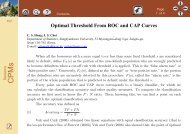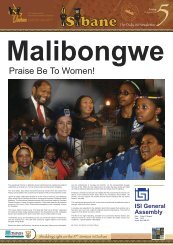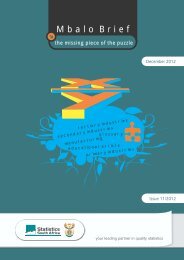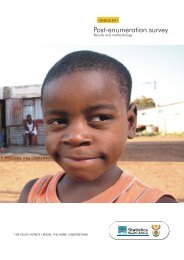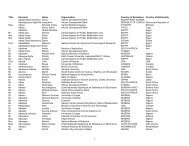General household survey - Statistics South Africa
General household survey - Statistics South Africa
General household survey - Statistics South Africa
You also want an ePaper? Increase the reach of your titles
YUMPU automatically turns print PDFs into web optimized ePapers that Google loves.
<strong>Statistics</strong> <strong>South</strong> <strong>Africa</strong> 44<br />
P0318<br />
18.3 Response rates<br />
The national response rate for the <strong>survey</strong> was 94,2%. The highest response rate (99,2%) was recorded in<br />
KwaZulu-Natal and the lowest in Gauteng (80,8%).<br />
Table 14: Response rates per province, GHS 2011<br />
Province Per cent<br />
Western Cape 91,3<br />
Eastern Cape 98,9<br />
Northern Cape 94,1<br />
Free State 97,3<br />
KwaZulu-Natal 99,2<br />
North West 97,0<br />
Gauteng 80,8<br />
Mpumalanga 97,6<br />
Limpopo 99,1<br />
<strong>South</strong> <strong>Africa</strong> 94,2<br />
18.4 Data revisions<br />
Stats SA revised the population model to produce mid-year population estimates during 2008 in the light of<br />
the findings of the Community Survey 2007 and new HIV/AIDS and mortality data. The new data have<br />
been used to adjust the benchmarking for all previous datasets. Weighting and benchmarking were also<br />
adjusted for the provincial boundaries that came into effect in December 2006. The data for the GHS 2002<br />
to GHS 2011 as presented in this release are therefore comparable.<br />
As a result of statistical programs used for weighting, which discards records with unspecified values for<br />
the benchmarking variables, namely age, sex and population group, it became necessary to impute<br />
missing values for these variables. A combination of logical and hot-deck imputation methods were used to<br />
impute the demographic variables of the whole series from 2002 to 2011.<br />
Household estimates that were developed using the UN headship ratio methodology were used to weight<br />
<strong>household</strong> files. The databases of Census 1996, Census 2001, Community Survey 2007 and the Labour<br />
Force Survey 2003, Labour Force Survey 2005, and Quarterly Labour Force Survey (quarter 3) of 2009<br />
were used to analyse trends and develop models to predict the number of <strong>household</strong>s for each year. The<br />
weighting system was based on tables for the expected distribution of <strong>household</strong> heads for specific age<br />
categories, per population group and province.<br />
Missing values and unknown values were excluded from totals used as denominators for the calculation of<br />
percentages, unless otherwise specified. Frequency values have been rounded off to the nearest<br />
thousand. Population totals in all tables reflect the population and sub-populations as calculated with SAS<br />
and rounded off. This will not always correspond exactly with the sum of the preceding rows because all<br />
numbers are rounded off to the nearest thousand.<br />
18.5 Limitations of the study<br />
It is important to note that the questionnaires for the GHS series were revised extensively in 2009 and that<br />
some questions might not be exactly comparable to the data series before then. Please refer to Section<br />
18.10 for more details about the questions that are not comparable. Analysts and users of the data are also<br />
advised not to do a comparative analysis over time before studying the questionnaires of the years<br />
concerned in detail, as there have also been small modifications to options to a number of questions that<br />
are not highlighted in Section 18.10. Unlike some previous years when data were collected only during<br />
July, the data collection since GHS 2009 was spread over a three-month period. This is not necessarily a<br />
limitation, but should be borne in mind when using the data for comparative purposes.<br />
<strong>General</strong> Household Survey, July 2011



